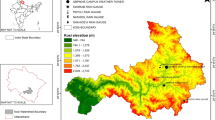Abstract
The relationship (\(\varvec{Z} = \varvec{AR}^{\varvec{b}}\)) between radar reflectivity factor,\(\varvec{ Z }\) and rainfall rate, \(\varvec{R }\) is studied using the micro rain radar (MRR) observation located over Darjeeling (27.05° N, 88.26° E, 2194 m above the msl) in the foothills of the eastern Himalayan Mountains during Indian summer monsoon and post monsoon seasons (June–October) 2013. Observations from MRR are classified mainly into two types, stratiform and convective, based on the bright band and non-bright band signatures in the radar reflectivity, respectively. We have observed 12 and 7 cases for the stratiform convective rain events, respectively. In the present study MRR is operated mostly during low intensity rainfall rate (0.02–20 mm/h). During southwest monsoon season \(\varvec{Z} {-} \varvec{R }\) relation for the stratiform and convective rainfall types are found to be \(\varvec{Z} = 272\varvec{R}^{1.78}\) and \(\varvec{Z} = 192\varvec{R}^{1.54}\) respectively. \(\varvec{Z} {-} \varvec{R }\) relation for both stratiform and convective rain shows high temporal variation during different months of monsoon and post monsoon seasons. The coefficient \(\varvec{A}\) varies between 225 and 289 for stratiform rain and between 153 and 235 for convective rain. The exponent \(\varvec{b}\) varies between 1.4 and 2.1 for stratiform rain while between 1.2 and 1.8 for convective rain. Interestingly, we observed a distinct relation with smaller values of \(\varvec{A}\) and \(\varvec{b}\) for convective rain than stratiform rain over Darjeeling. The height dependence of \(\varvec{A}\) and \(\varvec{b}\) are also studied which is found to be very small up to ~ 1.5 km above the surface for both types of the precipitating systems.








Similar content being viewed by others
References
Atlas, D., Srivastava, R., & Sekhon, R. S. (1973). Doppler radar characteristics of precipitation at vertical incidence. Reviews of Geophysics, 11(1), 1–35.
Atlas, D., Ulbrich, C. W., Marks, F. D., Black, R. A., Amitai, E., Willis, P. T., et al. (2000). Partitioning tropical oceanic convective and stratiform rains by draft strength. Journal of Geophysical Research: Atmospheres, 105(D2), 2259–2267.
Austin, P. M. (1987). Relation between measured radar reflectivity and surface rainfall. Monthly Weather Review, 115(5), 1053–1070.
Awaka, J., Le, M., Chandrasekar, V., Yoshida, N., Higashiuwatoko, T., Kubota, T., et al. (2016). Rain type classification algorithm module for GPM dual-frequency precipitation radar. Journal of Atmospheric and Oceanic Technology, 33(9), 1887–1898.
Battan, L. J. (1973). Radar observations of the atmosphere (p. 324). Chicago: The University of Chicago.
Bringi, V. N., Thurai, M., Nakagawa, K., Huang, G. J., Kobayashi, T., Adachi, A., et al. (2006). Rainfall estimation from C-band polarimetric radar in Okinawa, Japan: Comparisons with 2D-video disdrometer and 400 MHz wind profiler. Journal of the Meteorological Society of Japan. Ser. II, 84(4), 705–724.
Das, S., & Maitra, A. (2018). Characterization of tropical precipitation using drop size distribution and rain rate-radar reflectivity relation. Theoretical and Applied Climatology, 132(1–2), 275–286.
Das, S., Shukla, A. K., & Maitra, A. (2010). Investigation of vertical profile of rain microstructure at Ahmedabad in Indian tropical region. Advances in Space Research, 45(10), 1235–1243.
Fujiwara, M. (1965). Raindrop-size distribution from individual storms. Journal of the Atmospheric Sciences, 22(5), 585–591.
Gatlin, P. N., Thurai, M., Bringi, V. N., Petersen, W., Wolff, D., Tokay, A., et al. (2015). Searching for large raindrops: A global summary of two-dimensional video disdrometer observations. Journal of Applied Meteorology and Climatology, 54(5), 1069–1089.
Giangrande, S. E., Luke, E. P., & Kollias, P. (2012). Characterization of vertical velocity and drop size distribution parameters in widespread precipitation at ARM facilities. Journal of Applied Meteorology and Climatology, 51(2), 380–391.
Harikumar, R., Sampath, S., & Kumar, V. S. (2010). Variation of rain drop size distribution with rain rate at a few coastal and high altitude stations in southern peninsular India. Advances in Space Research, 45(4), 576–586.
Jash, D., Resmi, E., Unnikrishnan, C., Sumesh, R., Sreekanth, T., Sukumar, N., et al. (2019). Variation in rain drop size distribution and rain integral parameters during southwest monsoon over a tropical station: An inter-comparison of disdrometer and Micro Rain Radar. Atmospheric Research, 217, 24–36.
Joss, J., Schram, K., Thams, J., & Waldvogel, A. (1970). On the quantitative determination of precipitation by a radar (No. Wissenschaftliche mitteilung-63). Osservatorio Ticinese Della Centrale Meteorologica Svizzera Locarno-Monti.
Joss, J., & Waldvogel, A. (1969). Raindrop size distribution and sampling size errors. Journal of the Atmospheric Sciences, 26(3), 566–569.
Kim, D., Maki, M., & Lee, D. (2010). Retrieval of three-dimensional raindrop size distribution using X-band polarimetric radar data. Journal of Atmospheric and Oceanic Technology, 27(8), 1265–1285.
Kirankumar, N., Rao, T. N., Radhakrishna, B., & Rao, D. N. (2008). Statistical characteristics of raindrop size distribution in southwest monsoon season. Journal of Applied Meteorology and Climatology, 47(2), 576–590.
Klaassen, W. (1988). Radar observations and simulation of the melting layer of precipitation. Journal of the atmospheric sciences, 45(24), 3741–3753.
Lavanya, S., Kirankumar, N., Aneesh, S., Subrahmanyam, K., & Sijikumar, S. (2019). Seasonal variation of raindrop size distribution over a coastal station Thumba: A quantitative analysis. Atmospheric Research, 229, 86–99.
Maahn, M., & Kollias, P. (2012). Improved Micro Rain Radar snow measurements using Doppler spectra post-processing. Atmospheric Measurement Techniques, 5(11), 2661.
Marshall, J. S., & Palmer, W. M. K. (1948). The distribution of raindrops with size. Journal of meteorology, 5(4), 165–166.
Martner, B. E., Yuter, S. E., White, A. B., Matrosov, S. Y., Kingsmill, D. E., & Ralph, F. M. (2008). Raindrop size distributions and rain characteristics in California coastal rainfall for periods with and without a radar bright band. Journal of Hydrometeorology, 9(3), 408–425.
Marzuki, Hashiguchi, H., Shimomai, T., Rahayu, I., Vonnisa, I., & Afdal. (2016). Performance evaluation of micro rain radar over sumatra through comparison with disdrometer and wind profiler. Progress in Electromagnetics Research M, 50, 33–46.
Marzano, F., Mori, S., Chini, M., Pulvirenti, L., Pierdicca, N., Montopoli, M., et al. (2011). Potential of high-resolution detection and retrieval of precipitation fields from X-band spaceborne synthetic aperture radar over land. Hydrology and Earth System Sciences, 15(3), 859–875.
May, P. T., & Rajopadhyaya, D. K. (1996). Wind profiler observations of vertical motion and precipitation microphysics of a tropical squall line. Monthly Weather Review, 124(4), 621–633.
Peters, G., Fischer, B., Münster, H., Clemens, M., & Wagner, A. (2005). Profiles of raindrop size distributions as retrieved by microrain radars. Journal of Applied Meteorology, 44(12), 1930–1949.
Rao, T. N., Rao, D. N., Mohan, K., & Raghavan, S. (2001). Classification of tropical precipitating systems and associated Z–R relationships. Journal of Geophysical Research: Atmospheres, 106(D16), 17699–17711.
Rao, T. N., Rao, D. N., & Raghavan, S. (1999). Tropical precipitating systems observed with Indian MST radar. Radio Science, 34(5), 1125–1139.
Reddy, K. K., & Kozu, T. (2003). Measurements of raindrop size distribution over Gadanki during south-west and north-east monsoon. Indian Journal of Radio and Space Physics, 32, 286–295.
Reddy, K. K., Kozu, T., Ohno, Y., Jain, A., & Rao, D. N. (2005). Estimation of vertical profiles of raindrop size distribution from the VHF wind pro filer radar Doppler spectra. Indian Journal of Radio and Space Physics (IJRSP), 34(5), 319–327.
Rico-Ramirez, M., Cluckie, I., & Han, D. (2005). Correction of the bright band using dual-polarisation radar. Atmospheric Science Letters, 6(1), 40–46.
Short, D. A., Kozu, T., & Nakamura, K. (1990). Rainrate and raindrop size distribution observations in Darwin Australia. In Proceeding of Special Symposium on Regional Factors Affecting Radiowave Attenuation due to Rain, Rio de Janeiro, Brazil. International Union of Radio Science Commission, pp 35–40.
Steiner, M., & Houze, R. A. J. (1997). Sensitivity of the estimated monthly convective rain fraction to the choice of Z–R relation. Journal of Applied Meteorology, 36(5), 452–462.
Sumesh, R., Resmi, E., Unnikrishnan, C., Jash, D., Sreekanth, T., Resmi, M. M., et al. (2019). Microphysical aspects of tropical rainfall during Bright Band events at mid and high-altitude regions over Southern Western Ghats, India. Atmospheric Research, 227, 178–197.
Thurai, M., Gatlin, P. N., & Bringi, V. N. (2016). Separating stratiform and convective rain types based on the drop size distribution characteristics using 2D video disdrometer data. Atmospheric Research, 169, 416–423.
Tokay, A., & Short, D. A. (1996). Evidence from tropical raindrop spectra of the origin of rain from stratiform versus convective clouds. Journal of Applied Meteorology, 35(3), 355–371.
Tokay, A., Short, D. A., Williams, C. R., Ecklund, W. L., & Gage, K. S. (1999). Tropical rainfall associated with convective and stratiform clouds: Intercomparison of disdrometer and profiler measurements. Journal of Applied Meteorology, 38(3), 302–320.
Tridon, F., Van Baelen, J., & Pointin, Y. (2011). Aliasing in Micro Rain Radar data due to strong vertical winds. Geophysical Research Letters, 38(2), L02804.
Ulbrich, C. W., & Atlas, D. (2007). Microphysics of raindrop size spectra: Tropical continental and maritime storms. Journal of Applied Meteorology and Climatology, 46(11), 1777–1791.
White, A. B., Neiman, P. J., Ralph, F. M., Kingsmill, D. E., & Persson, P. O. G. (2003). Coastal orographic rainfall processes observed by radar during the California Land-Falling Jets Experiment. Journal of Hydrometeorology, 4(2), 264–282.
Williams, C. R. (2016). Reflectivity and liquid water content vertical decomposition diagrams to diagnose vertical evolution of raindrop size distributions. Journal of Atmospheric and Oceanic Technology, 33(3), 579–595.
Wilson, C. L., & Tan, J. (2001). The characteristics of rainfall and melting layer in Singapore: experimental results from radar and ground instruments. In Eleventh international conference on antennas and propagation (IEE Conf. Publ. No. 480) (Vol. 2, pp. 852–856).
Yuter, S. E., & Houze, R. A. J. (1997). Measurements of raindrop size distributions over the Pacific warm pool and implications for Z–R relations. Journal of Applied Meteorology, 36(7), 847–867.
Acknowledgements
This work is fully supported by supported by Intensification of Research in High Priority Area (IRHPA), Department of Science and Technology (DST), Govt. of India. We thank technical team members of the IRHPA project at Bose Institute for taking the MRR observations. First author (SM) is thankful to Department of Science and Technology, Govt. of India for providing the fellowship under IRHPA project. This work is partially supported by Department of Science and Technology—Science and Engineering Research Board (EMR/2015/000525). Authors also thank to SRM HPCC for processing of topography data. We thank two anonymous reviewers for their positive feedbacks which helps us a lot to improve this article.
Author information
Authors and Affiliations
Corresponding author
Additional information
Publisher's Note
Springer Nature remains neutral with regard to jurisdictional claims in published maps and institutional affiliations.
Rights and permissions
About this article
Cite this article
Mehta, S., Mehta, S.K., Singh, S. et al. Characteristics of the Z–R Relationships Observed Using Micro Rain Radar (MRR-2) over Darjeeling (27.05° N, 88.26° E): A Complex Terrain Region in the Eastern Himalayas. Pure Appl. Geophys. 177, 4521–4534 (2020). https://doi.org/10.1007/s00024-020-02472-6
Received:
Revised:
Accepted:
Published:
Issue Date:
DOI: https://doi.org/10.1007/s00024-020-02472-6




